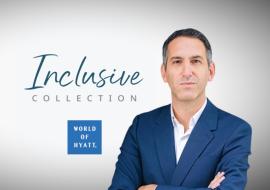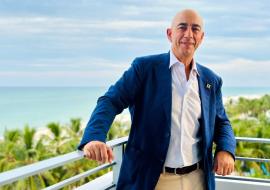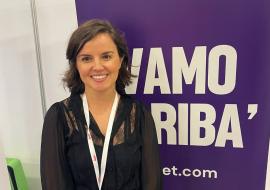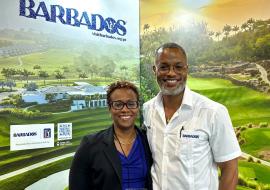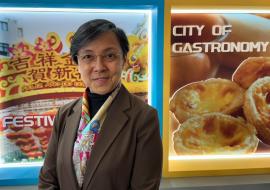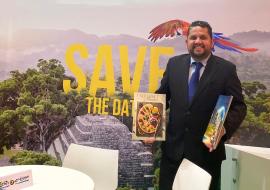Q & A with Tom Anderson, Head of the SuperClubs Sales & Marketing Division for the U.S. and Canadian markets
SuperClubs has been and continues to be a successful hotel project in the Caribbean and that’s owed in part to the inflows of guests from the U.S. and Canada –by far the company’s two largest outbound markets for its properties in several countries across the region. In an exclusive interview with Caribbean News Digital a few weeks ago during JAPEX 2008 in Kingston, Jamaica, Tom Anderson, Head of the SuperClubs Sales & Marketing Division for the American and Canadian markets, spelled out some of the plan the hotel chain has in store.
Q.- What’s exactly your responsibility in the U.S. and Canadian markets?
A.- My responsibilities include working with tour operators and travel agencies, as well as the markets outbound to the U.S. for our resorts in Jamaica, Curacao, the Dominican Republic, Brazil and the Bahamas.
Q.- Cuba is ruled out of your responsibilities. Is that right?
A.- No, not Cuba. We can’t sell Cuba in the United States. We do have a woman in Canada who is our assister there and she really sells it because I can’t have the responsibility for selling Cuba at this moment in time. Maybe that’s going to change in the future, it’s hard to say, but at this moment we sell everything but Cuba outbound from the United States.
Q.- What U.S. states generate the largest number of travelers to the SuperClubs hotels and in which countries?
A.- Jamaica is our principal marketplace. We have seven hotels there and we’ll be opening an eighth hotel in Jamaica, so for the United States that’s our number-one market by far. The number two would probably be the Bahamas because it’s very close to the United States and there are lots of daily flights to Nassau. But over time we also see Brazil as an expanding market for the United States.
Today our resorts are in Costa de Recife and Santa Lucia, but those are not easy for most Americans to get to. But there’s a resort under construction in Bouzios, which is a market much closer to Rio de Janeiro, and so Americans traveling there could make the transfer to Bouzios.
As to the largest U.S. markets for our resorts, they are New York and New Jersey, followed by the Midwest and, believe it or not, the Southeast of the United States has grown considerably to the Caribbean. Cities and markets like Atlanta, the Carolinas and Florida are growing significantly with people from there traveling to the Caribbean.
Q.- How many people from the U.S. and Canada travel every year to the SuperClubs resorts in Jamaica and other destinations?
A.- Tens of thousands of people travel annually to visit our resorts. Let me give it to you this way as straight as possible. Seventy percent or more of our business in Jamaica, or the eighty percent –depending on the time of year- come from the United States. Most of our resorts, however, are about 300 rooms or less. So, it’s thousands of passengers every year from Canada and the United States that go to our resorts. But it’s not in the millions because we don’t have so many resorts and so many guestrooms in each hotel. However, it’s an increasing market.
Over the last two to three years, our marketplace has increase by as much as 25 percent, I mean, from the United States in terms of the number of customers or guests that have enjoyed our resorts.
Q.- What’s the average age of the SuperClubs guests?
A.- That’s an excellent question. It depends on brands. For our Breezes resorts, the average age is somewhere between 25 and 45, either for couples or families, either younger couples with kids or younger couples who want to get away from their kids. At Hedonism, we find two age groups. One between 25 and 35, people who like partying and going a little crazy, and then there’s an older group which includes old hippies from the 1960s, who are 35-plus years old and they go a little crazy, too. The latter goes to Hedonism II and the first group goes to Hedonism III. Our Grand Lido resorts accommodate guests from 45 to 65, primarily couples, very few singles there.
Q.- And what’s the average stay in SuperClubs resorts for U.S. guests and people from elsewhere?
A.- That’s another very good question. The Jamaican people stay about three and a half days at our resorts. U.S. visitors spend about five and a half days, while people coming from Europe spend about seven to eight days, depending on what part of Europe their flights depart from. Canadians run very similar to U.S. travelers, sometimes up to seven days because they come down on charter flights and there’re far more charter flights out of Canada than from the United States.
Q.- What are the top European markets for your resorts?
A.- Our number-one ,market in Europe is the UK, followed by Germany, though this one is much smaller.
Q.- I wonder if you have allegiance programs tailor-made to specifically attract American travelers and others for Canadian visitors. Are there differences between the two of them?
A.- Yes, they are similar but different. Canadians travel more out of charter flights, with large retail agencies and a few wholesalers that are the charter operators. Groups like Sun Wing and Sun Quest; those are two pretty large tour groups up in Canada. In the United States, most of our business comes from tour operators or travel agencies, groups like Go-Go and Travel Impressions are two of the large companies we work with. Tour operators and travel agencies make up about 75 percent of our business, though we’re seeing an increasing number of customers coming through the Internet, which is the next wave of travel change. That’s probably about 15 percent of our business today, though we believe in coming years as much as of a third of our business will come from the Internet.
Q.- Do you have incentives for those groups you work with?
A.- Yes, we do have incentives for the agencies. We provide the tour operators with a net price and they sometimes allow the agencies a commission. We sometimes provide incentives for the consumers who buy from us directly.
Q.- But right now those incentives are only aimed at the trade, not at the consumers. Am I wrong?
A.- At this moment is only for the trade. We’re thinking about incentives for the consumers, but we haven’t done that yet. We have to be careful not to upset the travel trade when we do that. However, it’s something we’re looking at because the consumers get incentives from other companies we compete with, like Sandals and Couples, our two major competitors in the market, and we’re now beginning to see some increasing competition from Spanish chains like RIU and Iberostar. Those are formidable competitors we have to be prepared to compete with.
Q.- This comment of your leads to my next question. What do you make of the increasing competition posed by Spanish hotel chains in countries like Jamaica?
A.- It’s very strong competition. The Spanish groups are very well capitalized and they are intelligent. They run larger hotels and they are more at mass markets. Many of their customers come and enjoy their experience. Ours is more of a boutique hotel experience in which guests are a little closer to the beach, a little closer to the restaurant, but maybe you just want a quiet, happy Jamaican experience. They are different products, but I think they appeal to different customers as a result.







